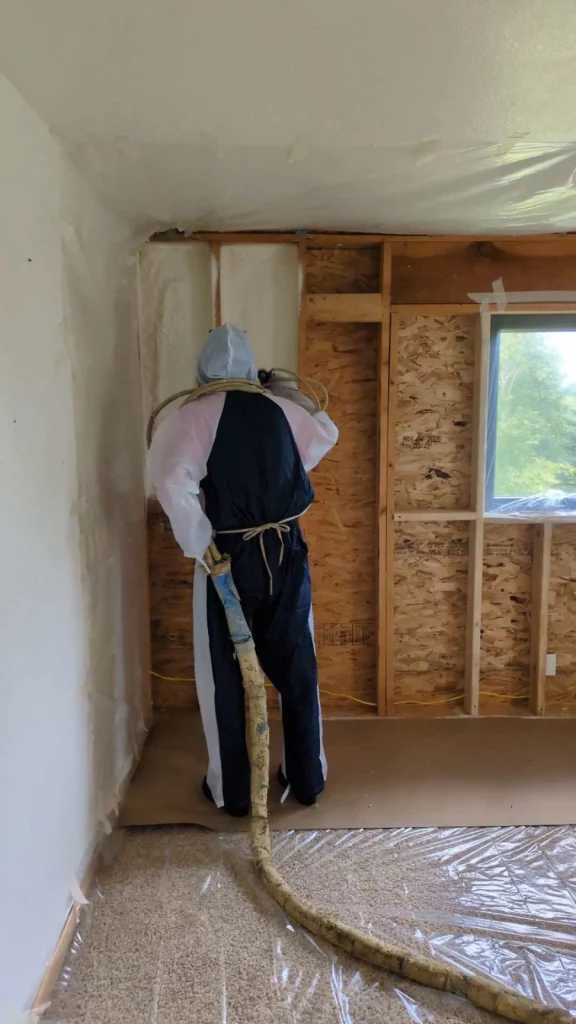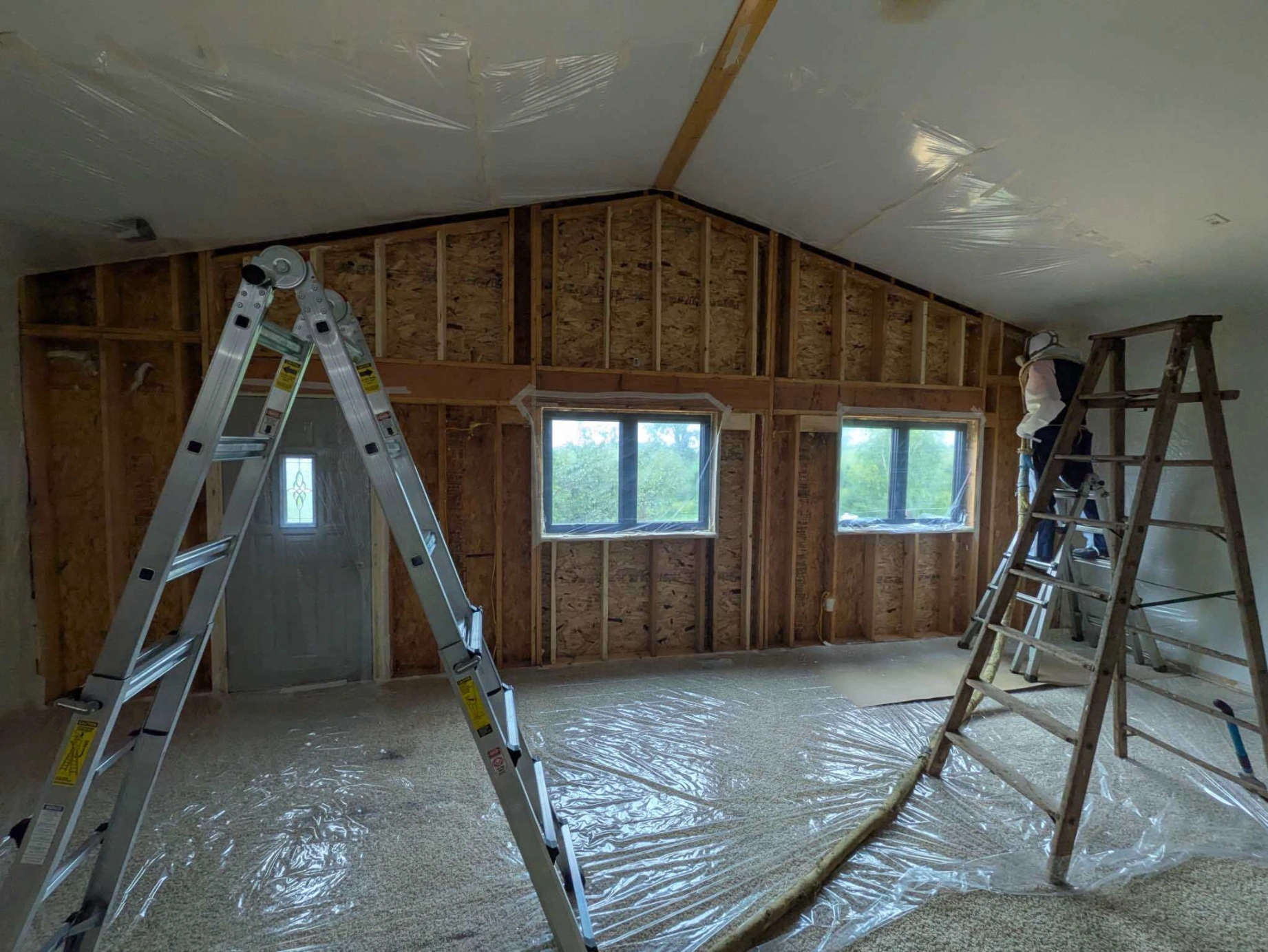Spray foam offers higher thermal resistance, better air sealing, and longer durability than traditional insulation materials like fiberglass or cellulose. Closed-cell spray foam in particular creates a rigid, moisture-resistant barrier that improves energy efficiency and structural strength. Traditional materials often leave gaps and degrade faster under moisture or temperature fluctuations.
For structures requiring long-term performance, moisture resistance, and high R-values per inch, spray foam insulation typically provides more consistent results. Foam Worx Insulation applies these systems across residential, commercial, and agricultural projects, where performance and lifespan matter most.
This guide outlines technical comparisons, key decision factors, and practical insights based on field experience with both systems.
Key Differences Between Spray Foam and Traditional Insulation
| Feature | Spray Foam (Closed-Cell) | Fiberglass Batts | Blown-In Cellulose |
|---|---|---|---|
| R-Value per inch | R-6.0 to R-7.5 | R-2.9 to R-3.8 | R-3.2 to R-3.8 |
| Air Sealing Capability | Excellent | Poor | Moderate |
| Moisture Resistance | High (closed-cell) | Low | Moderate |
| Lifespan | 20–30+ years | 10–25 years | 20–30 years |
| Structural Reinforcement | Yes (closed-cell only) | No | No |
| Mold and Pest Resistance | High | Low | Moderate |
| Application Complexity | Professional install required | DIY-friendly | Professional recommended |
| Space Efficiency | High (higher R-value in thinner layer) | Low | Moderate |
Technical Characteristics of Spray Foam Insulation
| Property | Closed-Cell Spray Foam |
|---|---|
| R-Value (per inch) | 6.5–7.5 |
| Vapor Permeability | <1 perm (acts as vapor barrier) |
| Expansion Rate | 30–40 times liquid volume |
| Cured Density | 1.75–2.0 lb/ft^3 |
| Fire Retardant Option | Yes (with intumescent coating) |
| Application Temperature Range | 40°F–120°F |
Consider Building Type, Climate, and Exposure Risk
Southern Minnesota’s climate with its freeze-thaw cycles, high humidity, and strong temperature swings requires insulation that resists moisture and delivers consistent performance over time. Closed-cell spray foam performs well in these conditions due to its high R-value and air sealing capabilities.
Bonus Tip:
In pole barns or metal buildings, using spray foam prevents condensation on interior surfaces and boosts structural rigidity.
Practical Benefits in Different Settings:
- Residential: Lower energy bills, draft prevention, and quieter indoor environment
- Commercial: Improved HVAC efficiency, code compliance, and longevity
- Agricultural: Barrier against moisture and pests, ideal for livestock shelters and storage

Before You Decide: Key Factors to Evaluate
- Structure Age and Design: Older homes with irregular framing often benefit more from spray foam due to coverage flexibility.
- Moisture Exposure: In basements or crawl spaces, closed-cell foam resists water better than batt or blown-in materials.
- Air Sealing Requirements: Spray foam reduces the need for additional air barriers.
- Access and Application Area: Areas with tight or complex geometry may be hard to insulate effectively using traditional methods.
Bonus Tip:
Use thermal imaging during energy audits to identify insulation weak points before choosing a system.
What Foam Worx Insulation Offers for This Type of Work
- Closed-Cell Spray Foam: High-performance insulation for structures needing strength, moisture protection, and air sealing.
- Residential Insulation: Attics, walls, crawl spaces, and basements sealed for efficiency.
- Commercial Insulation: Industrial-grade foam systems designed to meet code and operational demands.
- Blown-In Attic Insulation: A practical option for open attic spaces needing cost-effective coverage.
What People Ask Before Choosing an Insulation Type
How long does spray foam insulation last?
Closed-cell systems typically last over 30 years without sagging or settling if properly installed.
Can spray foam be used in older homes?
Yes. It adapts well to irregular framing and inaccessible cavities where batt insulation underperforms.
Is it safe to apply spray foam in occupied buildings?
Installations require temporary evacuation due to fumes. Reentry is safe after full curing and ventilation usually within 24 hours.
What areas benefit most from spray foam?
Basements, crawl spaces, rim joists, attics, and any space prone to air leaks or moisture exposure.
Get Expert Help Choosing the Right Insulation
Contact Foam Worx Insulation for guidance based on the building type, usage patterns, and climate conditions. Foam Worx Insulation can explain whether spray foam or traditional materials fit better for your project.
Email: [email protected] Phone: (507) 407-6688
Longer-Term Questions About Maintenance and Use
What maintenance does spray foam need over time?
None in most cases. Inspect periodically for physical damage in high-traffic areas or areas affected by renovations.
Can spray foam be painted or coated?
Yes. Intumescent paint can be applied for fire code compliance or aesthetic finishes.
Does spray foam insulation degrade under UV light?
Yes. Exposure to sunlight causes deterioration. Always cover with drywall or UV-resistant coating.
How does spray foam perform in extreme temperatures?
It retains R-value in subzero conditions and remains stable up to 180°F, making it suitable for attics and exterior walls.
Are there environmental concerns with spray foam?
Some older formulations contained high-GWP blowing agents. Current products often use eco-friendlier alternatives like HFOs.




